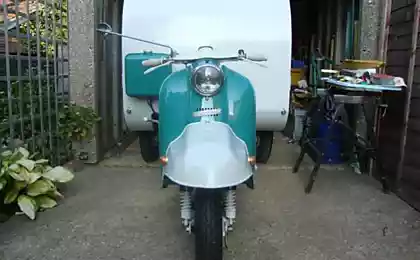1806
Ant
Few people know that in the Soviet Union since the late 50s has been launched wide release scooters (we now call it a scooter). Along with the car models in the series and has gone cargo version - Ant. About Tula scooters will be my story.
Initially, the text written for my blog: gessor.livejournal.com/
The selection will be 53 pictures
It all began April 27, 1957, when the production line in Tula Engineering Plant officially came first scooter (we now call it a scooter) Tula T-200.
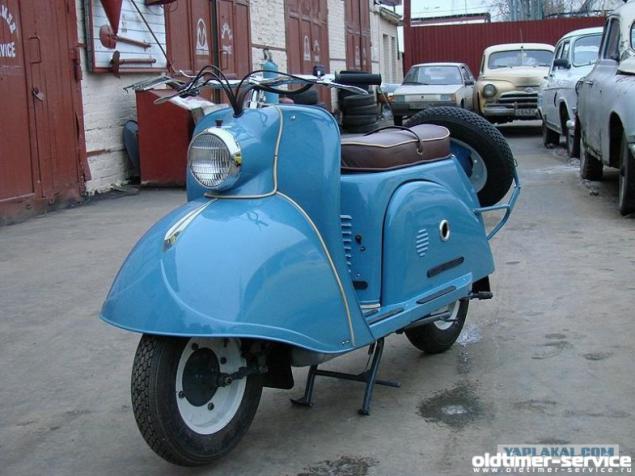
The progenitor of Tula became Goggo-roller TA200 is available in German.

Tula had vosmisilny engine capacity of 199 cm3, 4-speed gearbox in one unit with a motor, chain drive rear-wheel drive, 10-inch wheels, fork push-type front suspension. -155 Kg weight, the maximum speed - 80 km / h, the fuel consumption when traveling at 45-50km / h to 100 km - not more than 3, 4 liter. Fuel tank capacity 11 liters + 0, 5 reserve, allows the use of gasoline A-66. She also had a forced air cooling, electrical start instead of a kick starter and monotube shock absorbers, while almost never used even on motorcycles.
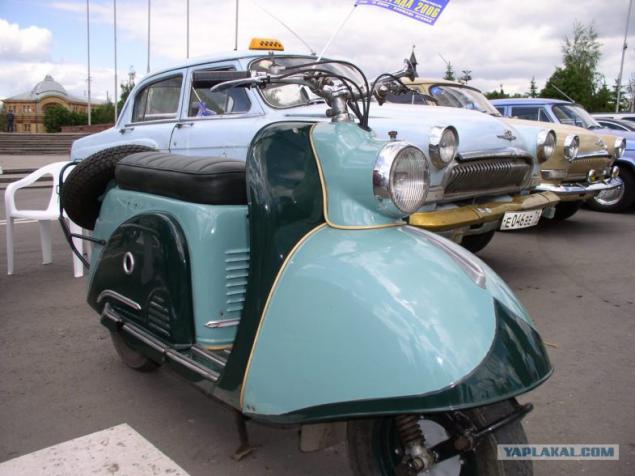
label

On the dashboard was a speedometer, a central switch (to turn on the light, and combined with the ignition switch), the gear indicator, transmission neutral indicator (green eye) and battery charge indicator (red eye), and under the panel was the hook for bags.
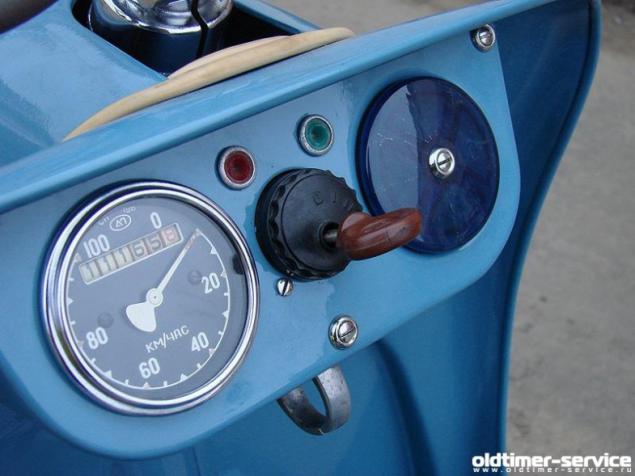
At the foot pedal is located to the left shift, and right - the rear brake pedal.
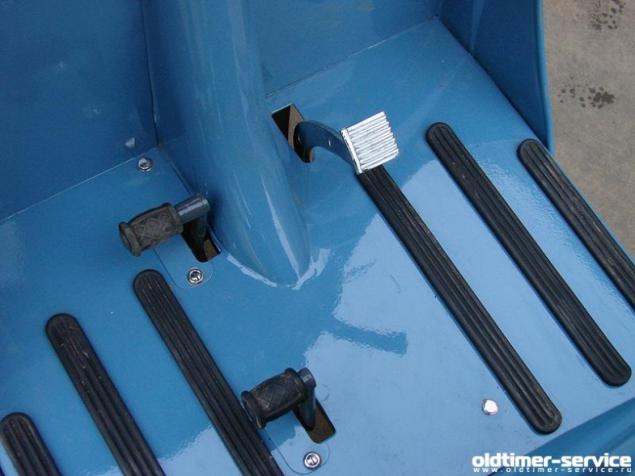
Engine compartment was equipped with a lamp on these models, it was removed.

In 1961 he published the updated "Tula", the model T-200M, whose weight has been reduced to 145 kg, and power through the use of a modified cylinder head has increased to 9 liters. from. In addition she received a kick-starter, changed the type of front fork. Instead fork arm suspension with push-type began to use the plug pulling the type and main visual difference - both in shape wing, as well as many other details.
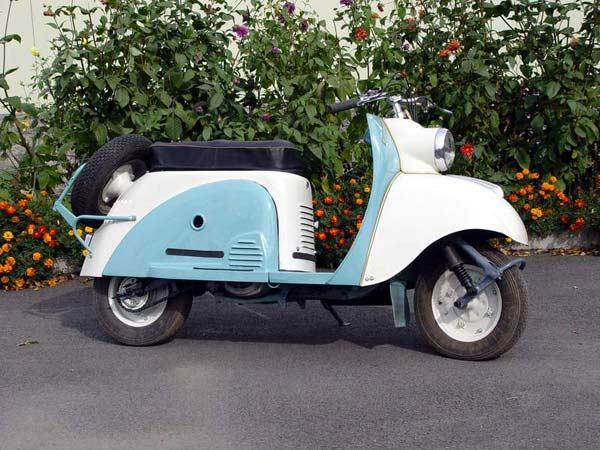
Front view.

Under the saddle was a tool box.
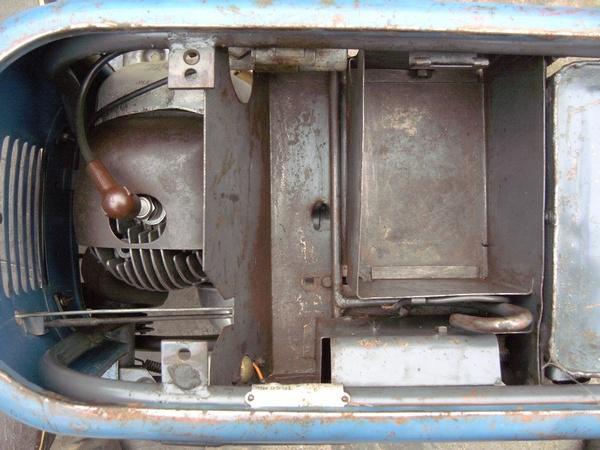
Harness as well as the T-200 was a scooter.
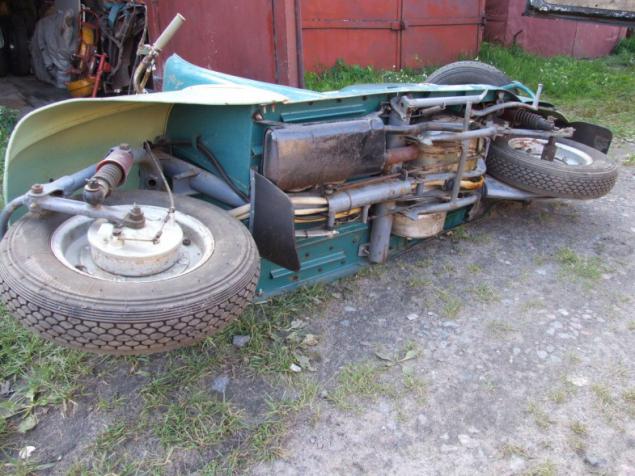
In 1961 he was released batch of 94 cars scooter with sidecar T-200K. Body "wheelchair" was borrowed from the side of the trailer, "IL-56" frame had an original design. Chassis scooter has been strengthened.

Another option

Next upgrades occurred in 1967, the model was named "Tourist". In this structure has been eliminated most of the shortcomings scooter T-200 / T-200M. Carrier hood would eliminate the massive tubular subframe at the rear, new front fork lever push type provided good handling. Scooter had a significantly redesigned. Old, but forced the engine by making some adjustments (due to improved valve timing, shape of combustion chambers and increasing the compression ratio), increased capacity by 20% - from 9 hp at 4500 rev / min. up to 11 hp at 5600 rev / min. Increasing the compression ratio required the use of petrol with an octane rating of at least 72. The maximum speed - 85 km / hour, the tank is 12 liters, fuel consumption 3-3, 5 liters per 100 km, as there were turn signals, which have not been in a regular performed in the T-200M. Body "tourist" has become much stronger, the center of gravity significantly decreased. Wing front wheel positioned tool box.
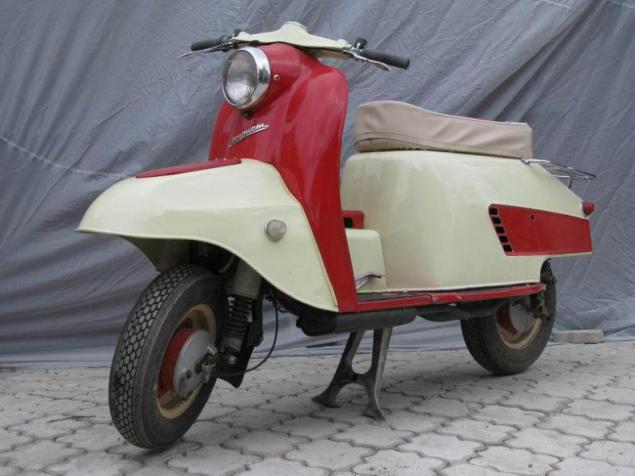
In 1971 he was made the modernization of "tourists". Model called "Tourist-M." The most basic - the compression ratio has been increased to the number 7, 8, the engine now runs on gasoline A-76, and its maximum power increased to 12 hp Top speed increased to 90 km / h. Scooter has a new cigar-shaped muffler type. Tool box, which initially was located in a niche housing front wheel, moved under the seat.
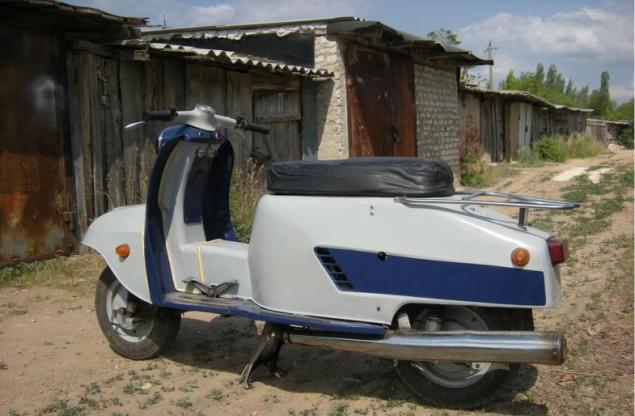
Before the driver was located speedometer on the left was a switch beam / low beam and horn button on the right turn signal switch, a wheel was 3 sight glass, light neutral (green), the battery (red eye), LED direction indicators (orange ). Below them was the ignition key and switch on the light, and the lower - closing panel wiring.
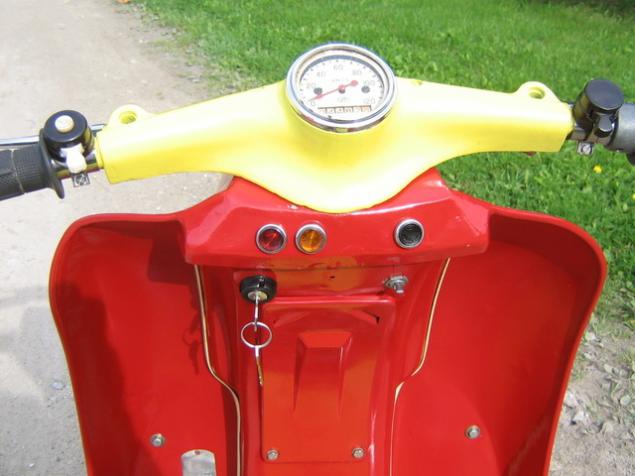
In 1978 he started serial production of scooter "Tulitsa" (modernization of tourist-M). He got the engine with an aluminum cylinder and a cast-iron sleeve (which will completely get rid of a major disaster, "the pot" - sticking piston), three-channel venting. All this has increased the maximum engine output to 14 hp The car felt better up to 140 kg and had a maximum speed of 97 km / h. Externally, the new scooter is not very different from the "tourist" - it can be found only in a cast aluminum wheel hub and shortened muffler.
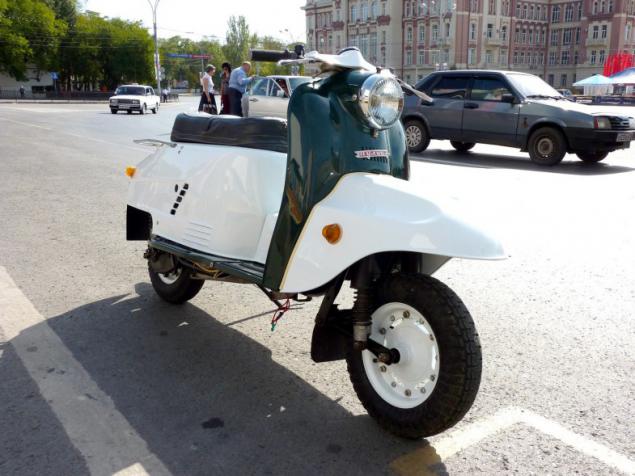
More
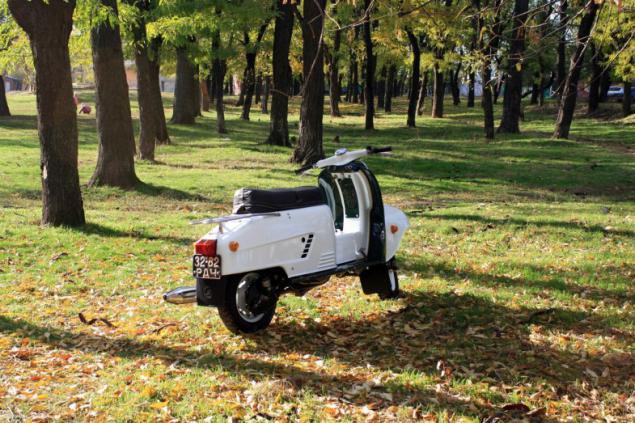
And so

Last modification 1986 Tulitsa-02M. As always, the increased power and reduced weight: 14, 5 hp and 134 kg, placed at the inlet valve petal, which reduced fuel consumption, and also upgraded trim. The maximum speed of 100 km / h.
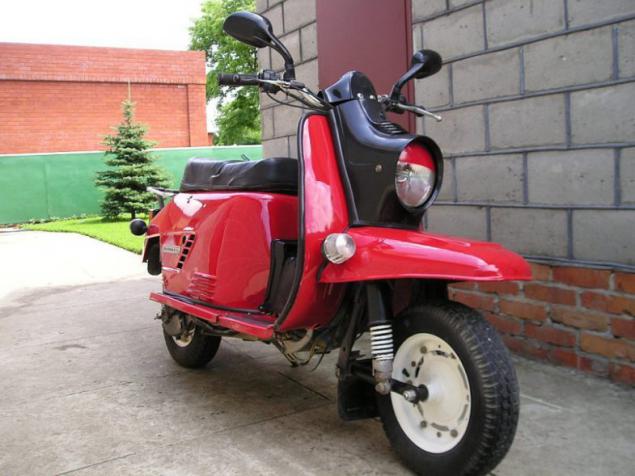
The story ends with passenger scooters, but on the basis of each of them was created by the cargo scooter, in fact it was the passenger version, it was just behind the 2 wheels and the body. Freight scooters were even more popular than cars, they were all with different factory index, but called them in one word - Ant.
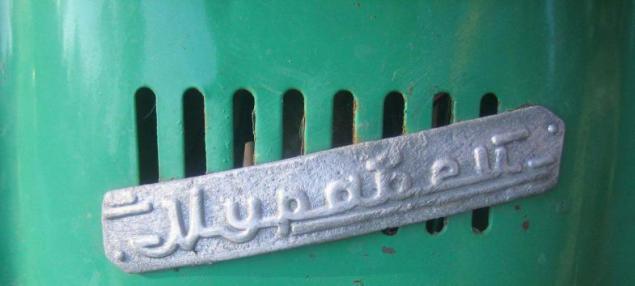
In early 1957 the first models of scooter truck TG-200 (the name "ant" has not worn) were produced and began road tests.
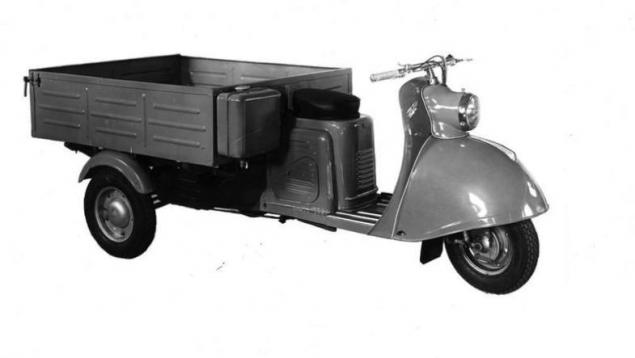
The prototypes - used units of output in Serpukhov wheel motorized wheelchairs: differential and balancers. The rest of the cargo scooter had unified with the passenger units: engine, steering with the front suspension fork and wheel, steering, electrical system, exhaust system, front panel with decking, a casing of the front wheel, the front wheel brake, electrical and engine silencer. Thanks to the differential, scooter got a reverse gear. In tests it was necessary, in addition to the electric starter, have an understudy - Kick, later introduced him to the car and scooter T-200M. After a brief of its release, this model has been redesigned and manufactured in such a way until now, only the design changed facing, saddle, handlebars. On the basis of scooter TG-200 was developed and mastered the production of its modifications-trailers and trailers isothermal TG and TG-200F-200I.
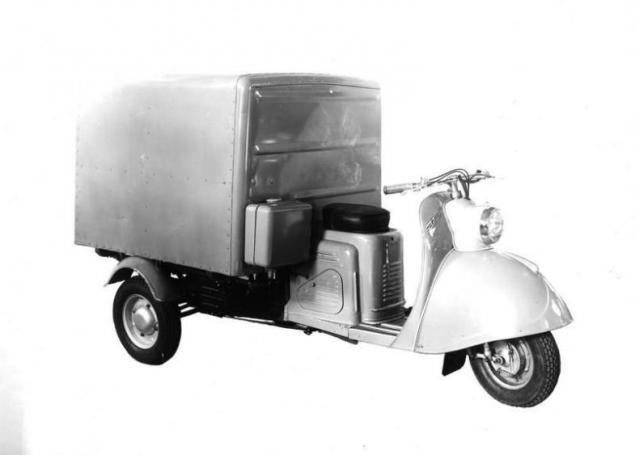
In addition, during the operation of the consumer revealed the need to change the parameters of the steering and the rigidity of the front suspension, so the scooter has been made yet, and steering damper.
The first production-wheel scooter TG-200 had the following technical data: 2-stroke engine, the working volume of 199 cm3, power 8 hp, load capacity of 200 kg, a maximum speed of 50 km / h., The fuel consumption per 100 km. - Up to 7 yrs. mass of 265 kg (with the body) and 310 kg (with a van).
All changes, which improve passenger scooter immediately implemented and cargo scooter, therefore, in principle, on the engine can not be anything new to say, except that each time the scooter had increased cargo load and maximum speed.
After the appearance of the upgraded T-Tula 200M in 1962, underwent a similar modernization of cargo scooter. He had the same index of TG-200.
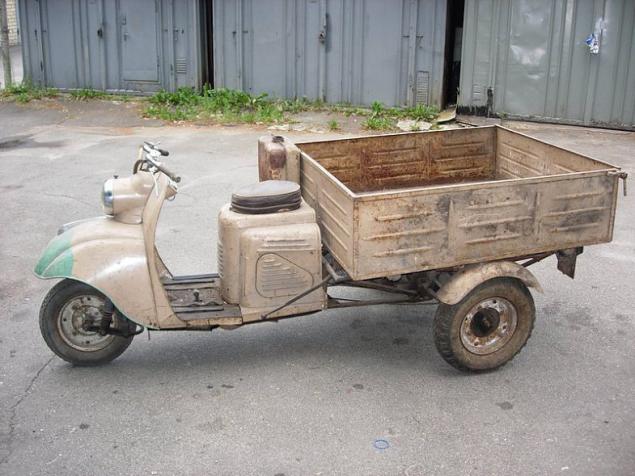
The first production motor "Tourist" left the assembly line in 1967, and in 1968 began production of scooter truck TGA-200 "Ant" to the basic model of the new nodes and increased up to 250 kg load capacity.
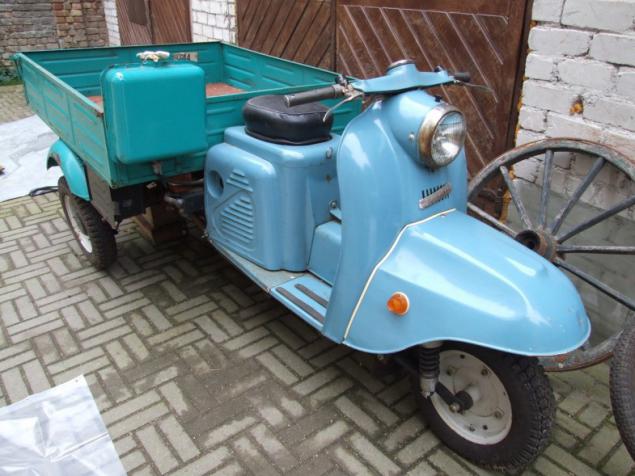
Under the body was spare wheel and tool box.
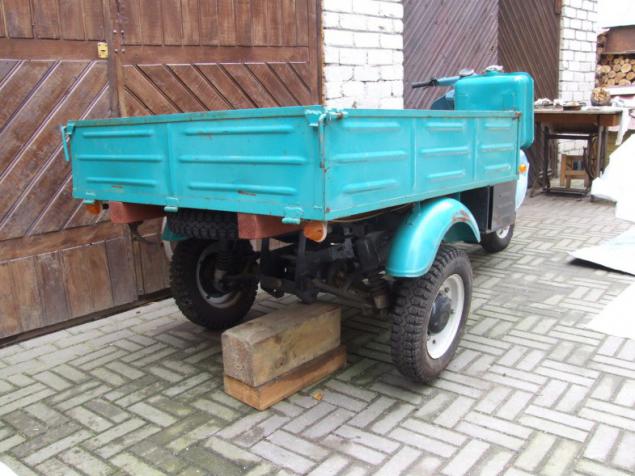
Battery and wiring as well as tourists and were Tulitsa between the legs of the driver.

There was also a combi version, no less popular than the cargo.
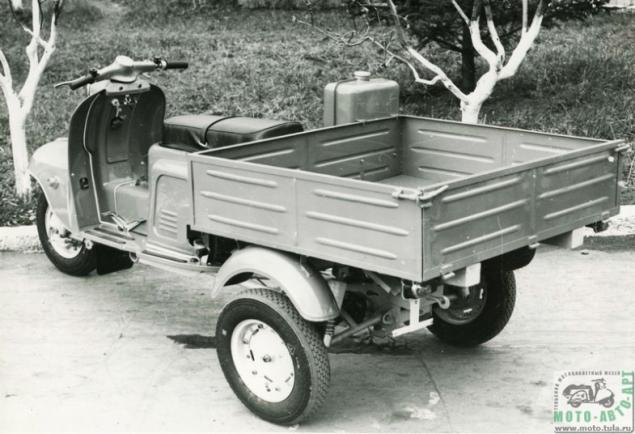
In 1980 he began to produce a new family of wheel scooter on the basis of units "Tulitsa" symbolically with increased load capacity up to 255 kg (index TGA-200-01). Since 1983, the gradual introduction of a new range of models of nodes (TMZ-5.403). The first phase was mastered production of new tubular adjustable steering wheel, air filter with a plastic housing and paper filter element installed more efficient carburetor K62.
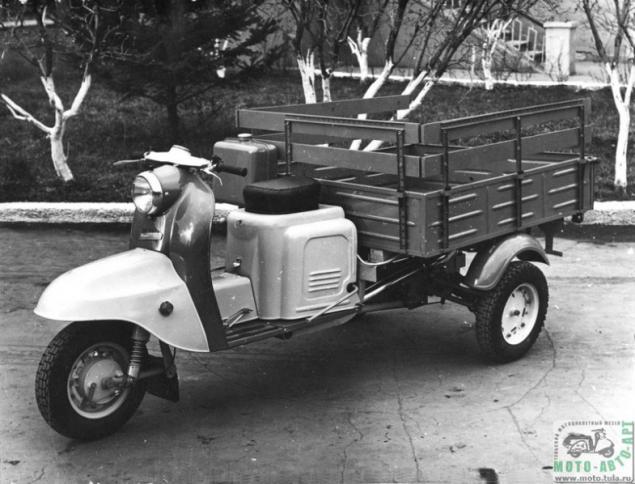
In 1986 he received a motor facing a new form - the fruit of collective work of the factory designers. Passenger motor scooter was called "Tulitsa 2", and freight, which due to an updated engine load rose to 320 kg - the index of inventories, 5.403-01 or Ant 2.
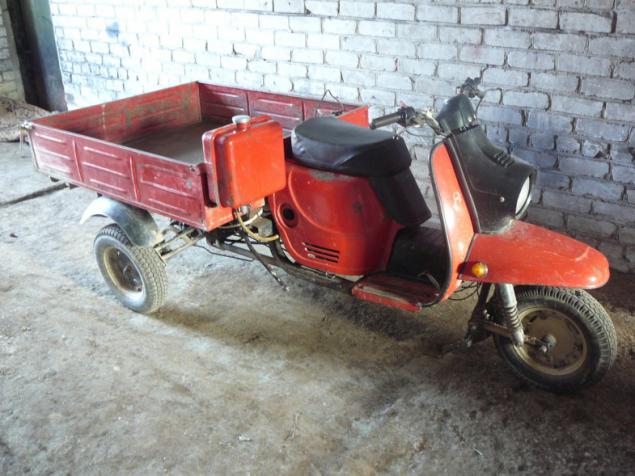
Here's a
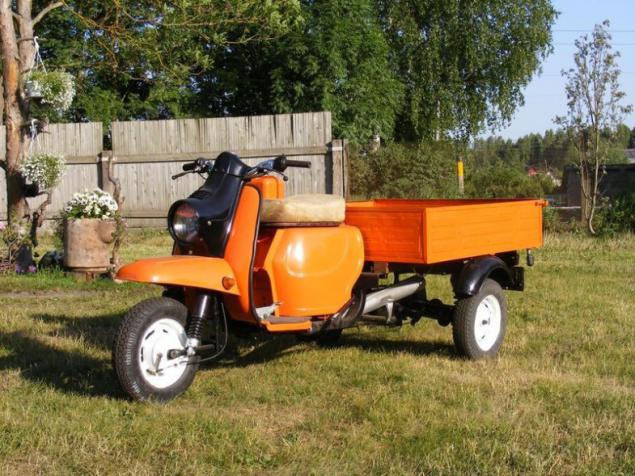
He
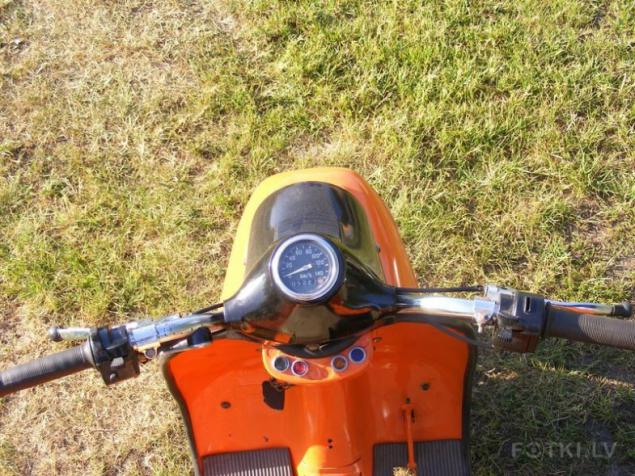
Back view.
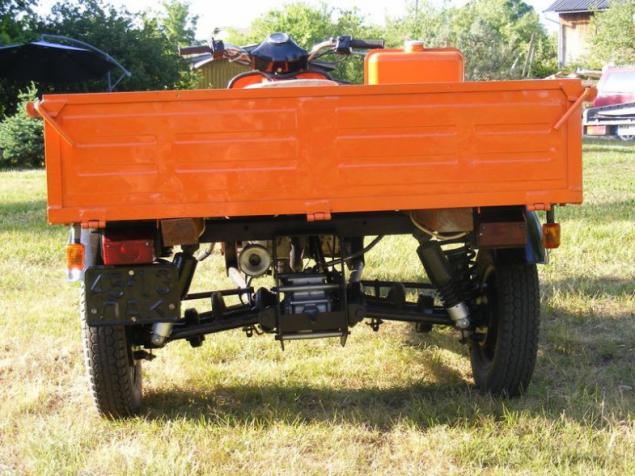
Another one.
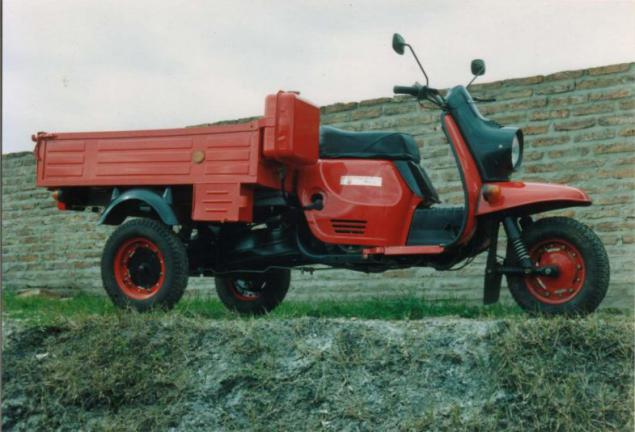
Tula mini the trucks were extremely popular in the country and abroad - from inventories produced in 1988 97,996 scooters share "Ants" was 84%. It is significant that spare parts can now be bought not only by local artisans, but also with plants in the Czech Republic, Poland and, of course, China.
For wheel scooter produced versions with closed cabin. They were a stamped welded construction of sheet steel of 50 kg. Glass pan type provides a good overview, it was equipped with a manually operated wiper. Doors with rubber seal and soft seat make the trip to the cabin comfortable enough. Due to the heat removed from the running engine at temperatures down to -25 ° C in the cabin temperature did not fall below + 8.
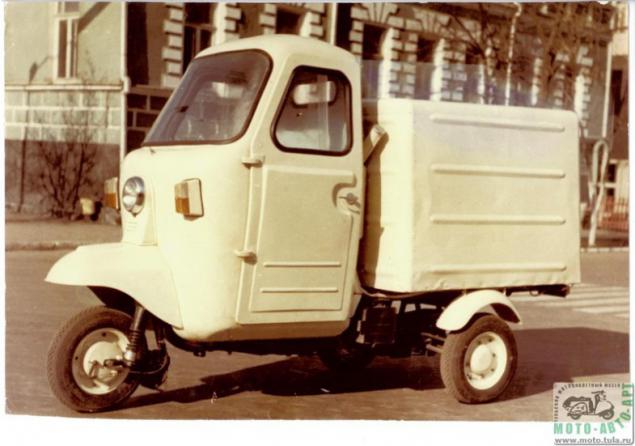
Since the mid-90s were produced in the same plastic cockpit. But both options cabins are very rare nowadays.

The unusual order was received by the late '50s: to produce a batch of motorcycle taxi ENEA. Design documentation was developed in conjunction with TSKEB, and in 1960 a party of 50 T-200T motorcycle taxi came to the customer. These machines were docked to the back of cars scooter outdoor double body design is quite simple, with two front steering wheels.

On the postcard.
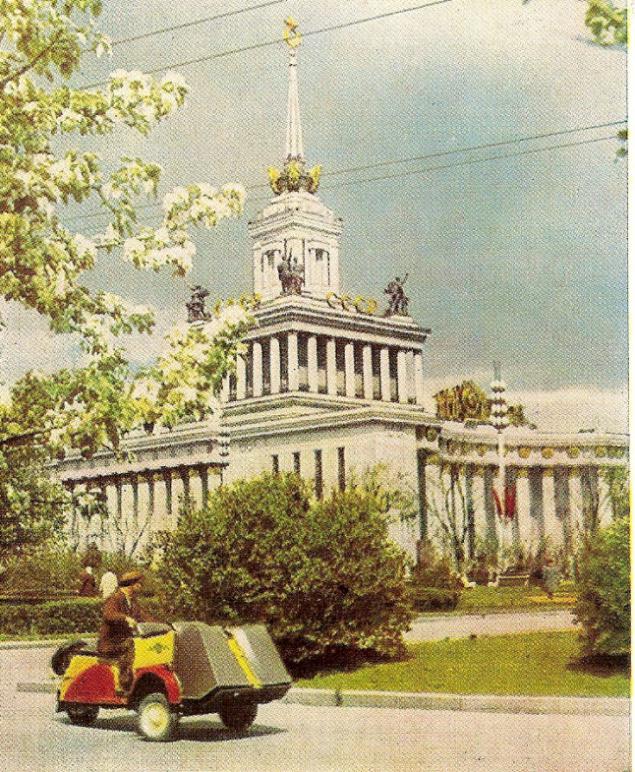
For easy driver protection from the weather and a headwind for cars and scooters since 1960 to stop production of scooters manufactured removable wind shield.
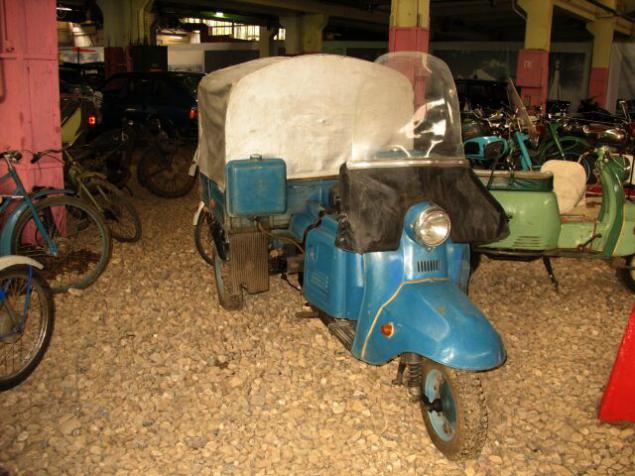
Cargo scooter has always enjoyed high demand in foreign markets, and to expand exports to the 1989-1991 year, work was done to create documentation for assembly groups kits cargo scooter and motorcycle enterprises to Mexico, Colombia and Argentina. Supervised experienced bureau chief E.I.Gololobov. Sending articles of kits has significantly reduce the cost of transportation of exported motor vehicles. The total number of items of equipment made up 12 868 recipients of products.
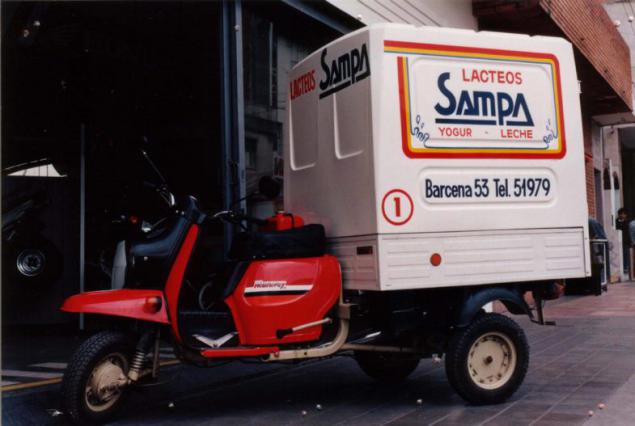
Ant in the service of the Argentine police =)
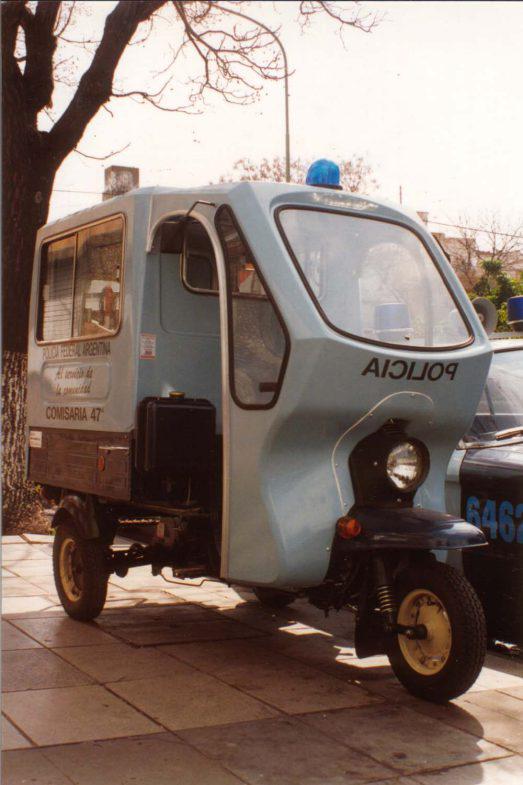
More
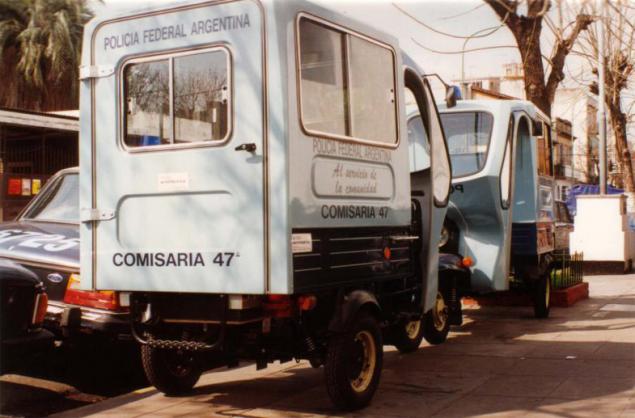
Also in 1985 began mass production motorcycle terrain "Tula" TMZ-5.951.
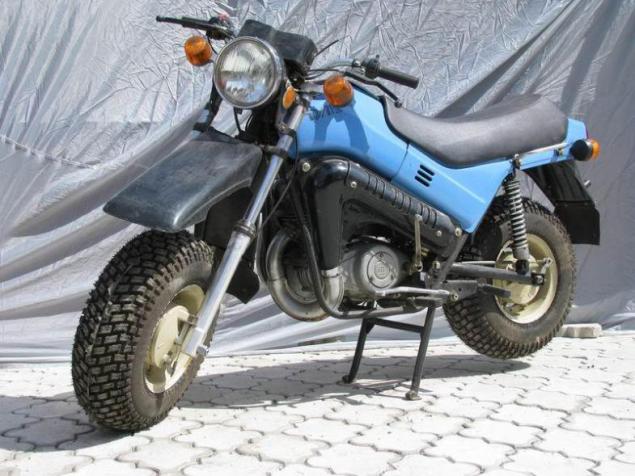
The most striking feature of the machines were large-size tire 6, 70-10. " The bike had a completely new design with the exception of the engine. He was fitted with conventional Tula was two hundred cc engine with the petal valve inlet and had a capacity of 15 horsepower. After the modernization in '89 bike received an index "5,952."
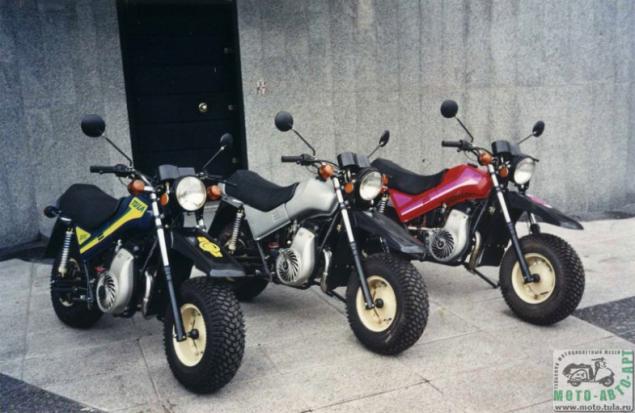
There was an option of Tula terrain on three wheels, it was 5,971, and the index was named Tula tricycle. All nodes were identical bike, just behind the gear was of ants, if necessary, it was easy to be converted into a two-wheeled version.
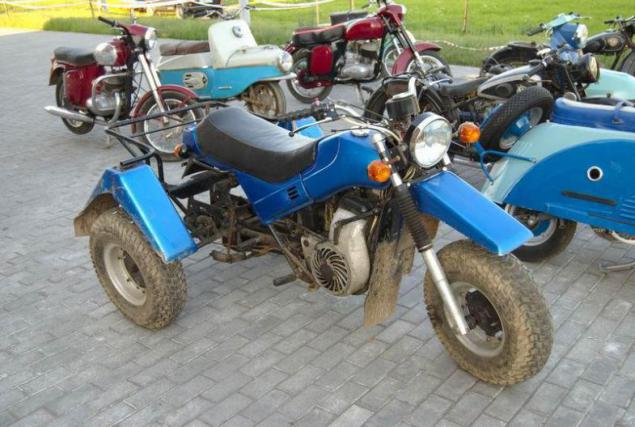
The same plant had many different designs that have existed either as a pilot or were released in limited quantities. For example ant with tipper body.

Side
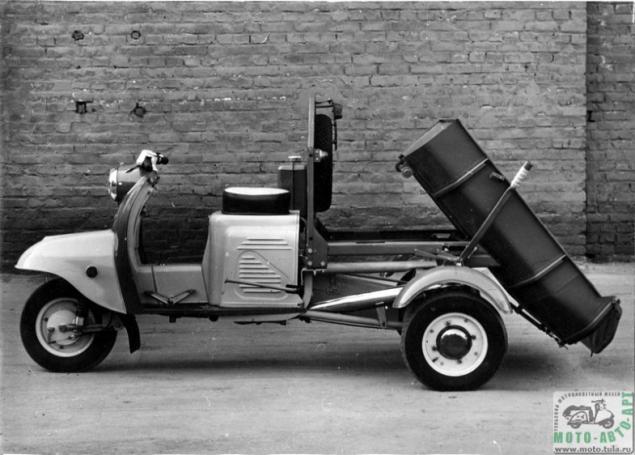
Dump module to the passenger Tula scooters.
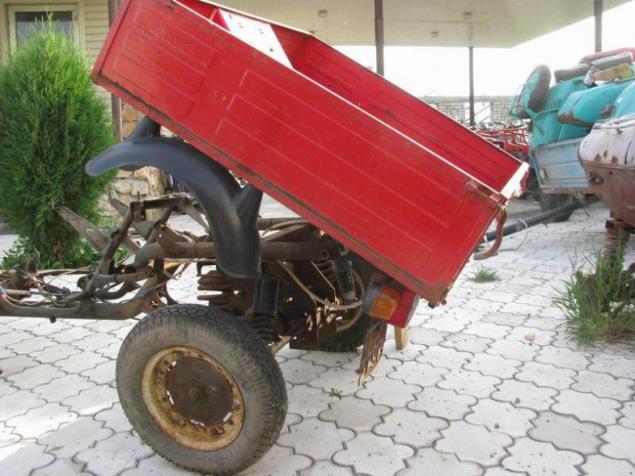
He mounted on the passenger scooter.
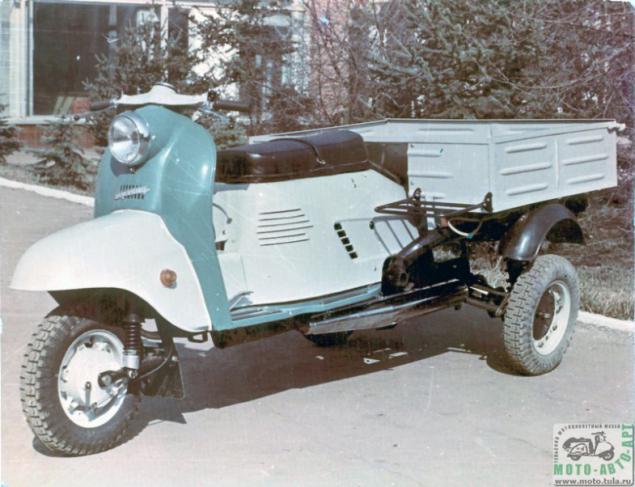
It was the development of cargo scooter "Ant-4" with a cabin and a diesel engine, designed for long service life (80 thous. Km) and large capacity (620 kg) for use in urban areas and in rural areas.
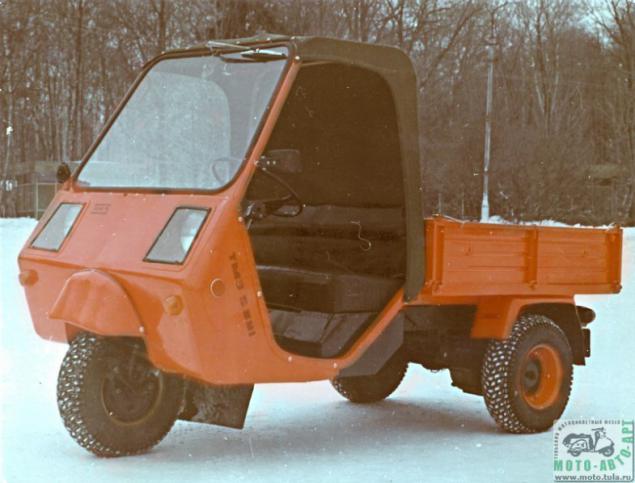
And these models:
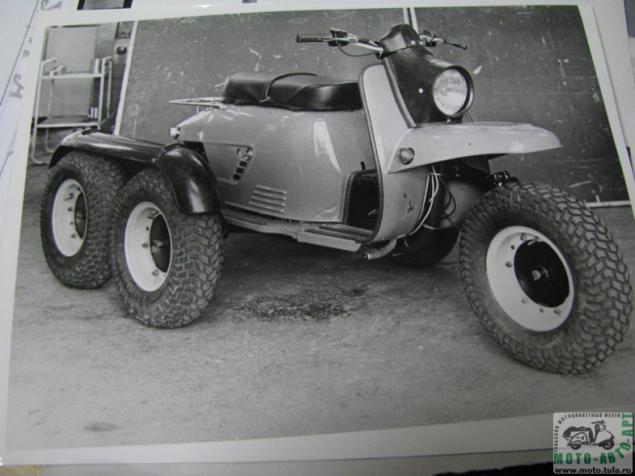
And so.
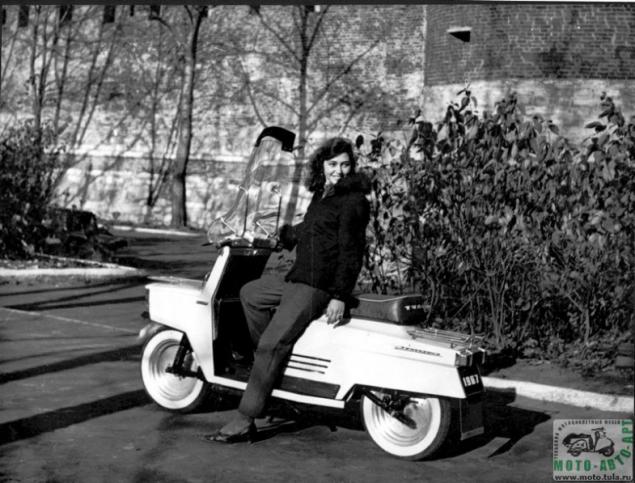
Much attention was paid to the development of completely new 250 cc engine, but to put it on the motor did not start.
There have been attempts to recreate the production in 90 years, it has developed and released a limited edition scooter frigate, which could not compete with the Japanese counterparts and the crisis ...
Dobavleno1 in [mergetime] 1292941494 [/ mergetime]
Since 1995, the plant has ceased to produce all motorcycle production equipment was sold and now the factory TULAMASH make some machine guns ...
(END) =)
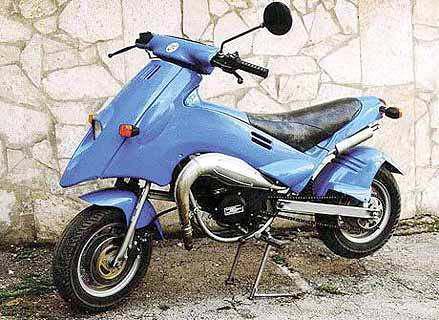
Source:
Initially, the text written for my blog: gessor.livejournal.com/
The selection will be 53 pictures
It all began April 27, 1957, when the production line in Tula Engineering Plant officially came first scooter (we now call it a scooter) Tula T-200.

The progenitor of Tula became Goggo-roller TA200 is available in German.

Tula had vosmisilny engine capacity of 199 cm3, 4-speed gearbox in one unit with a motor, chain drive rear-wheel drive, 10-inch wheels, fork push-type front suspension. -155 Kg weight, the maximum speed - 80 km / h, the fuel consumption when traveling at 45-50km / h to 100 km - not more than 3, 4 liter. Fuel tank capacity 11 liters + 0, 5 reserve, allows the use of gasoline A-66. She also had a forced air cooling, electrical start instead of a kick starter and monotube shock absorbers, while almost never used even on motorcycles.

label

On the dashboard was a speedometer, a central switch (to turn on the light, and combined with the ignition switch), the gear indicator, transmission neutral indicator (green eye) and battery charge indicator (red eye), and under the panel was the hook for bags.

At the foot pedal is located to the left shift, and right - the rear brake pedal.

Engine compartment was equipped with a lamp on these models, it was removed.

In 1961 he published the updated "Tula", the model T-200M, whose weight has been reduced to 145 kg, and power through the use of a modified cylinder head has increased to 9 liters. from. In addition she received a kick-starter, changed the type of front fork. Instead fork arm suspension with push-type began to use the plug pulling the type and main visual difference - both in shape wing, as well as many other details.

Front view.

Under the saddle was a tool box.

Harness as well as the T-200 was a scooter.

In 1961 he was released batch of 94 cars scooter with sidecar T-200K. Body "wheelchair" was borrowed from the side of the trailer, "IL-56" frame had an original design. Chassis scooter has been strengthened.

Another option

Next upgrades occurred in 1967, the model was named "Tourist". In this structure has been eliminated most of the shortcomings scooter T-200 / T-200M. Carrier hood would eliminate the massive tubular subframe at the rear, new front fork lever push type provided good handling. Scooter had a significantly redesigned. Old, but forced the engine by making some adjustments (due to improved valve timing, shape of combustion chambers and increasing the compression ratio), increased capacity by 20% - from 9 hp at 4500 rev / min. up to 11 hp at 5600 rev / min. Increasing the compression ratio required the use of petrol with an octane rating of at least 72. The maximum speed - 85 km / hour, the tank is 12 liters, fuel consumption 3-3, 5 liters per 100 km, as there were turn signals, which have not been in a regular performed in the T-200M. Body "tourist" has become much stronger, the center of gravity significantly decreased. Wing front wheel positioned tool box.

In 1971 he was made the modernization of "tourists". Model called "Tourist-M." The most basic - the compression ratio has been increased to the number 7, 8, the engine now runs on gasoline A-76, and its maximum power increased to 12 hp Top speed increased to 90 km / h. Scooter has a new cigar-shaped muffler type. Tool box, which initially was located in a niche housing front wheel, moved under the seat.

Before the driver was located speedometer on the left was a switch beam / low beam and horn button on the right turn signal switch, a wheel was 3 sight glass, light neutral (green), the battery (red eye), LED direction indicators (orange ). Below them was the ignition key and switch on the light, and the lower - closing panel wiring.

In 1978 he started serial production of scooter "Tulitsa" (modernization of tourist-M). He got the engine with an aluminum cylinder and a cast-iron sleeve (which will completely get rid of a major disaster, "the pot" - sticking piston), three-channel venting. All this has increased the maximum engine output to 14 hp The car felt better up to 140 kg and had a maximum speed of 97 km / h. Externally, the new scooter is not very different from the "tourist" - it can be found only in a cast aluminum wheel hub and shortened muffler.

More

And so

Last modification 1986 Tulitsa-02M. As always, the increased power and reduced weight: 14, 5 hp and 134 kg, placed at the inlet valve petal, which reduced fuel consumption, and also upgraded trim. The maximum speed of 100 km / h.

The story ends with passenger scooters, but on the basis of each of them was created by the cargo scooter, in fact it was the passenger version, it was just behind the 2 wheels and the body. Freight scooters were even more popular than cars, they were all with different factory index, but called them in one word - Ant.

In early 1957 the first models of scooter truck TG-200 (the name "ant" has not worn) were produced and began road tests.

The prototypes - used units of output in Serpukhov wheel motorized wheelchairs: differential and balancers. The rest of the cargo scooter had unified with the passenger units: engine, steering with the front suspension fork and wheel, steering, electrical system, exhaust system, front panel with decking, a casing of the front wheel, the front wheel brake, electrical and engine silencer. Thanks to the differential, scooter got a reverse gear. In tests it was necessary, in addition to the electric starter, have an understudy - Kick, later introduced him to the car and scooter T-200M. After a brief of its release, this model has been redesigned and manufactured in such a way until now, only the design changed facing, saddle, handlebars. On the basis of scooter TG-200 was developed and mastered the production of its modifications-trailers and trailers isothermal TG and TG-200F-200I.

In addition, during the operation of the consumer revealed the need to change the parameters of the steering and the rigidity of the front suspension, so the scooter has been made yet, and steering damper.
The first production-wheel scooter TG-200 had the following technical data: 2-stroke engine, the working volume of 199 cm3, power 8 hp, load capacity of 200 kg, a maximum speed of 50 km / h., The fuel consumption per 100 km. - Up to 7 yrs. mass of 265 kg (with the body) and 310 kg (with a van).
All changes, which improve passenger scooter immediately implemented and cargo scooter, therefore, in principle, on the engine can not be anything new to say, except that each time the scooter had increased cargo load and maximum speed.
After the appearance of the upgraded T-Tula 200M in 1962, underwent a similar modernization of cargo scooter. He had the same index of TG-200.

The first production motor "Tourist" left the assembly line in 1967, and in 1968 began production of scooter truck TGA-200 "Ant" to the basic model of the new nodes and increased up to 250 kg load capacity.

Under the body was spare wheel and tool box.

Battery and wiring as well as tourists and were Tulitsa between the legs of the driver.

There was also a combi version, no less popular than the cargo.

In 1980 he began to produce a new family of wheel scooter on the basis of units "Tulitsa" symbolically with increased load capacity up to 255 kg (index TGA-200-01). Since 1983, the gradual introduction of a new range of models of nodes (TMZ-5.403). The first phase was mastered production of new tubular adjustable steering wheel, air filter with a plastic housing and paper filter element installed more efficient carburetor K62.

In 1986 he received a motor facing a new form - the fruit of collective work of the factory designers. Passenger motor scooter was called "Tulitsa 2", and freight, which due to an updated engine load rose to 320 kg - the index of inventories, 5.403-01 or Ant 2.

Here's a

He

Back view.

Another one.

Tula mini the trucks were extremely popular in the country and abroad - from inventories produced in 1988 97,996 scooters share "Ants" was 84%. It is significant that spare parts can now be bought not only by local artisans, but also with plants in the Czech Republic, Poland and, of course, China.
For wheel scooter produced versions with closed cabin. They were a stamped welded construction of sheet steel of 50 kg. Glass pan type provides a good overview, it was equipped with a manually operated wiper. Doors with rubber seal and soft seat make the trip to the cabin comfortable enough. Due to the heat removed from the running engine at temperatures down to -25 ° C in the cabin temperature did not fall below + 8.

Since the mid-90s were produced in the same plastic cockpit. But both options cabins are very rare nowadays.

The unusual order was received by the late '50s: to produce a batch of motorcycle taxi ENEA. Design documentation was developed in conjunction with TSKEB, and in 1960 a party of 50 T-200T motorcycle taxi came to the customer. These machines were docked to the back of cars scooter outdoor double body design is quite simple, with two front steering wheels.

On the postcard.

For easy driver protection from the weather and a headwind for cars and scooters since 1960 to stop production of scooters manufactured removable wind shield.

Cargo scooter has always enjoyed high demand in foreign markets, and to expand exports to the 1989-1991 year, work was done to create documentation for assembly groups kits cargo scooter and motorcycle enterprises to Mexico, Colombia and Argentina. Supervised experienced bureau chief E.I.Gololobov. Sending articles of kits has significantly reduce the cost of transportation of exported motor vehicles. The total number of items of equipment made up 12 868 recipients of products.

Ant in the service of the Argentine police =)

More

Also in 1985 began mass production motorcycle terrain "Tula" TMZ-5.951.

The most striking feature of the machines were large-size tire 6, 70-10. " The bike had a completely new design with the exception of the engine. He was fitted with conventional Tula was two hundred cc engine with the petal valve inlet and had a capacity of 15 horsepower. After the modernization in '89 bike received an index "5,952."

There was an option of Tula terrain on three wheels, it was 5,971, and the index was named Tula tricycle. All nodes were identical bike, just behind the gear was of ants, if necessary, it was easy to be converted into a two-wheeled version.

The same plant had many different designs that have existed either as a pilot or were released in limited quantities. For example ant with tipper body.

Side

Dump module to the passenger Tula scooters.

He mounted on the passenger scooter.

It was the development of cargo scooter "Ant-4" with a cabin and a diesel engine, designed for long service life (80 thous. Km) and large capacity (620 kg) for use in urban areas and in rural areas.

And these models:

And so.

Much attention was paid to the development of completely new 250 cc engine, but to put it on the motor did not start.
There have been attempts to recreate the production in 90 years, it has developed and released a limited edition scooter frigate, which could not compete with the Japanese counterparts and the crisis ...
Dobavleno1 in [mergetime] 1292941494 [/ mergetime]
Since 1995, the plant has ceased to produce all motorcycle production equipment was sold and now the factory TULAMASH make some machine guns ...
(END) =)

Source:
Dogs barabaki or unusual 43 Infantry
Educational program for the oil industry or the oil in plain language






